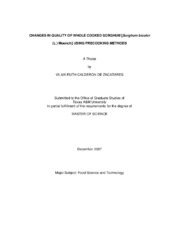| dc.description.abstract | Four sorghum cultivars (white, sumac, high tannin and black) differing in
kernel characteristics were evaluated for cooking quality using whole, cracked
and decorticated kernels. Whole grain had longer minimum cooking time (MCT)
and lower water uptake. MCT ranged from 20 to 55 min for all varieties. Soluble
solid loses (SSL) were lower than for cracked grain (1.0 to 1.5%). Formation of a
gruel-like texture, darker pericarp color, splitting and agglomeration of kernels
occurred especially for white grain.
Cracked sorghum had shorter MCT (8.8. to 17.5 min) but produced higher
SSL (1.3 to 2.9%). Changes in color and appearance due to leaching of
pigments especially for the sorghums with a pigmented testa occurred.
Utilization of decorticated kernels reduced MCT (11 to 25.3 min), but nutritional
value is affected with the removal of the pericarp, plus the SSL (0.5 to 0.7%)
produced during cooking.
The long grain rice types have comparatively lower values in terms of
MCT (22 min) than whole sorghum and SSL are similar to values obtained for
cracked grain (1.7 to 2.2%) showing a minimum of splitting. Short and medium
rice grain shows relatively long cooking time (30 to 35 min) but no longer than
cracked or decorticated sorghum and produced higher SSL (28% to 40%) during
processing, showing extensive disintegration. When sorghum was precooked; cooking quality improved. The
combination of dry heat and microwave reduced MCT and SSL from 31 to 49%
and 6.6 to 41.3%, respectively for all varieties compared to the control. This
treatment produced grain with softer texture, increased dietary fiber and higher
antioxidant activity retention (67.8%) for the tannin varieties than the control
(22.7%).
Evaluations of cooking quality of whole sorghum and the application of
precooking process have more applications than just preparation of rice-like
products. Whole boiled sorghum could be used in the elaboration of
nutraceutical foods like an ingredient for yogurts, desserts or side dishes like
exotic salads with other cereals. The inclusion of whole boiled sorghum as an
ingredient in foods is promising with excellent potential health benefits. | en |


